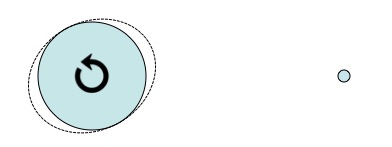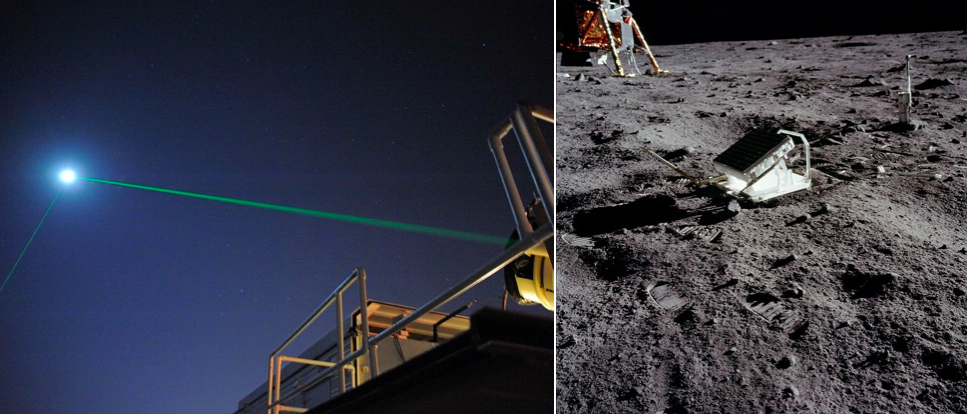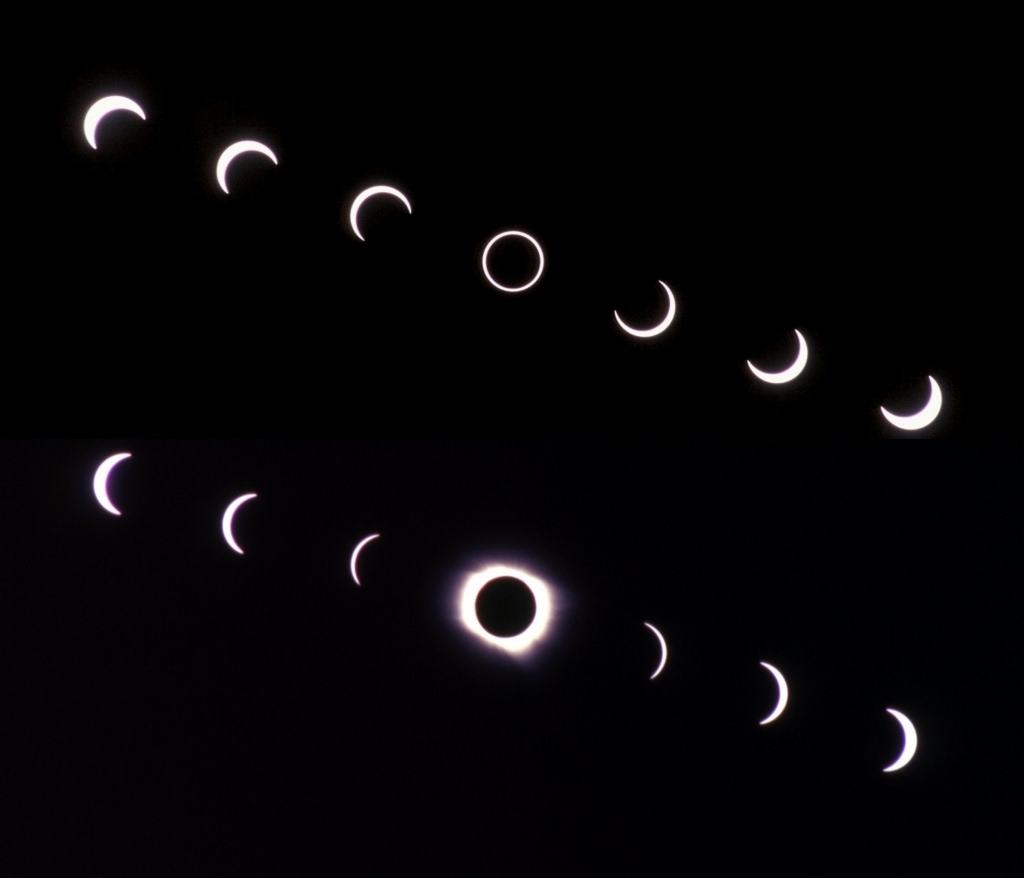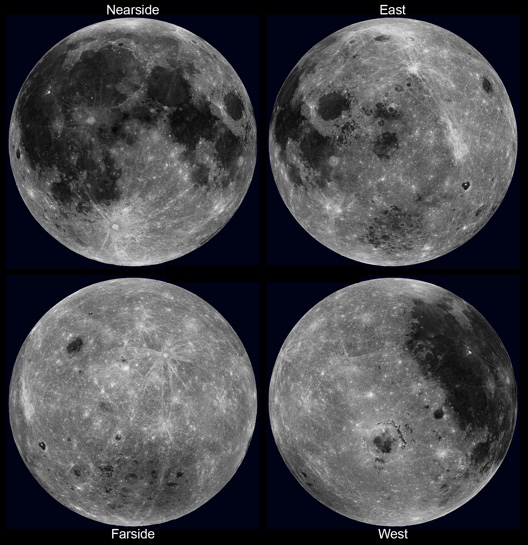Physicist: Almost prohibitively!
Ever since the Moon entered the scene 4.5 billion years ago, it’s been slowly drifting away. Initially it was around 15 times closer and bigger across in the sky. The effects that push it away decrease rapidly with distance, so the Moon climbed most of the distance to its current orbit early, but even today it gains about 4 cm per year.

Earth’s tidal bulges (the water distended by the Moon’s tidal forces) are dragged of the Moon by Earth’s rotation. That extra water pulls the Moon a forward a tiny amount, speeding it up and elevating its orbit.
The tides raised by the Moon are made up of a lot of water and that water, like all matter, creates gravity. The Earth turns in the same direction that the Moon orbits and, since water doesn’t instantly slosh back to where it’s supposed to be, the tidal bulge is dragged a little ahead of the Moon. The nearly insignificant gravity generated by that extra water pulls the Moon forward and speeds it up. The effect is especially small, since a nearly identical bulge appears on the opposite side of the Earth, pulling in the wrong direction. The difference is that the forward water bulge is slightly closer.
If you’re in orbit and you start moving faster, your orbit gets higher (ironically you end up slowing down overall, just higher and slower). At the same time that the tidal bulge pulls on the Moon, the Moon pulls on that bulge, slowing the Earth.

The effect that gives the Moon more orbital energy is a small effect (a couple extra meters of water on the surface of Earth, slightly leading the Moon) acting over a comparatively large distance. The overall effect is so small that we could, with fantastic but feasible effort, counteract it.
So while the Moon drifts away, days on Earth get longer. According to coral records, as recently as half a billion years ago the day was a mere 22 hours. Corals aren’t inherently clerical, but they do have both daily and yearly growth cycles with corresponding growth rings. And 4.5 billion years ago, before the Moon had siphoned off so much of our rotational inertia, a day on Earth was a mere 6 hours. Give or take (there wasn’t any coral at the time to obsessively write it down). So the Moon is drifting away and in exchange we Earthlings get both lunch and brunch.
A retro-reflector is a clever set of three mutually perpendicular mirrors that reflect any light back toward where it came from, regardless of where that is. Basically, if someone shoots you with a laser, wearing a suit covered in retro-reflectors is the fastest way to get revenge. By bouncing lasers off of any of five sets of retro-reflectors left on the Moon between 1969 and 1973 by the USA and USSR, we can determine the distance to the Moon to within millimeters and have found that, at present, the Moon is drifting away at a sedate 4 cm per year.

Left: The Terrestrial half of the Lunar ranging program. Right: The Lunar half. Only a handful of photons from the original laser bounces off of that little square and makes it back to be detected. So on the left, that isn’t a laser going out and coming back; it’s two lasers going out.
Given enough time, the Moon would eventually escape entirely. Luckily, in about five billion years the Sun will swell up and destroy both the Earth and Moon before that happens. So: nothing to worry about.
However! If we’d like to continue being the only planet to have both annular and total solar eclipses (the only objective measure of planetary exceptionalism), we need to act fast in the next several million years to keep the Moon from getting any farther away.

Earth, with our Moon, is the only known planet to see both annular (top) and total (bottom) eclipses. In a total eclipse the Sun is totally covered, leaving only the fainter corona around it visible. This is what we stand to lose.
The Moon is “rolling down a hill”, energetically speaking, and this total needs to be expended every year (effectively) forever to keep the Moon from “rolling” any farther away. Unlike practically every other question about planetary-scale engineering, “Project Sisyphus” is not impossible! Merely so expensive and pointless that it may as well be.
Anything that moves in a circle has angular momentum. Something a Moon with mass m orbiting at a radius of R around a planet with mass M in a universe with gravitational constant G will have an angular momentum of:
As r gets bigger (as the Moon moves away), L increases. To hold the Moon in place we’d need to counteract that increase and keep the angular momentum of the Moon constant. To figure out how much L changes over small distances (and 4 cm counts), we just find the differential. This is what calculus is good at: finding tiny changes in one thing, dL, given tiny changes in something else, dr.
Ion drives have exhaust velocities much higher than the escape velocity of the Moon, which is good; otherwise they wouldn’t be rockets moving the Moon, so much as fountains decorating the Moon. They’re also the most efficient type of space propulsion, maxing out around 80% efficiency. The most powerful use about 100 kW of power and are capable of generating about 5N of force (about 1 pound).
One of these drives, pushing for a year, could add or subtract
from the Moon’s orbital angular momentum.
So we could counter the Moon’s annual energy gain with a mere 24.5 million of our most powerful ion drives, each coupled with (at least) a 50 m by 50 m array of solar cells and batteries to supply the 100kW they need (including inefficiencies and the lack of Sun at night). Powering those drives to keep the Moon in place only requires a modest one sixth of the total energy generated by people every year (as of now). So if we really, really felt like doing it, this is the sort of “problem” that could be “solved” with little more than the greatest collective effort in human history.
If you lived on the Moon, you could build a statue pointing at the Earth and you’d never have to change it, because the Moon’s orientation is fixed with respect to the Earth. If that statue is pointing straight up, it’s in the middle of the justifiably-named “near side”. For exactly the same reason, you could build a statue pointing in the direction the Moon is moving as it orbits. If the statue were pointing straight up, it would be in the middle of the west side, near Mare Orientale.

The hemispheres of the Moon. The nearside (upper left) should look familiar. As seen in this nearside picture, the Moon is moving left toward the western hemisphere (lower right). Mare Orientale is that central dark crater that may as well say “place breaking rockets here”.
If we put all of those ion drives, their batteries, and solar panels in Mare Orientale, they would cover about 75% of it. Combined with all of the access roads and support structures, there’d be scarcely a single stone left unturned.
Each of those ion drives would need on the order of a ton of gas every year (argon and xenon are popular choices) to use as propellant. This is the stuff that would literally be thrown in the direction the Moon is moving in order to slow it down. Summed over the millions of drives, the gas continuously fired from the Moon by Project Sisyphus would be on par with the peak loss of gas in comets as they pass through the inner solar system. That is: on a clear night we would be able to see the gas as a ghostly comet tail extending, in a very straight band, from the left side of the Moon (from the right side for our southern hemisphere readers. G’day and dia bom!).
We can harvest enough argon from our atmosphere (it’s about 1% of the air you’re breathing now) to provide propellant for the next 2 billion years, so we’ll have time to figure out another option before we exhaust the supply. The Falcon Heavy could carry enough argon for about a dozen or two of the 24.5 million drives, so we’d need to launch several thousand of them to the Moon every day until we find a better system.
Compared to that, actually building and maintaining all of the infrastructure on the Moon would be difficult. It would be a lot easier to harvest everything (steel for structures, silicon for solar cells, etc.) we need from the Moon directly. So the damage wouldn’t be restricted to just Mare Orientale; there would be deep scars all over the Moon from where we tore up the place for mining.
So the Moon is drifting away, meaning that in a few hundred million years we won’t have total eclipses and the tide will be slightly more mild. With an achievable, but mind-boggling, effort we could stop the Moon from drifting away and ensure that our descendants can, in several hundred million years, continue to appreciate a slightly wider variety of astronomical phenomena (assuming eyes are still in style). In ten million years our barely-human descendants will curse us for handing this chore down to them, and in a hundred million years their definitely-not-human descendants will shake their cyber-tentacles at us in fury.
But you guys. I think we should try it.







I have what may be an easier solution, but I’m not sure it will work. Would isolating various sections of the Earth’s oceans help? We could build a series of dams in the oceans to dampen the tides.
For instance, one would go from South America to Antarctica. Add another from South Africa to Antarctica, and a few more to wall off the northern part of the Atlantic. The tides would then slosh back and forth across the Atlantic with no net effect.
The Pacific ocean is admittedly harder to wall off, but perhaps we could induce some helpful plate-tectonic or volcanic activity.
We could then use the Falcon Heavies for more useful purposes, such as providing our Martian colonists with all the Teslas they could possibly desire. (Come to think of it, we’d probably all rather be on Mars once the geologic activity was in full swing.)
Successfully damming the ocean would probably be harder than building millions of ion drives on the moon; while the tides move slowly they move with -incredible- force. And that’s not even getting into the myriad of issues involved in engineering things that can survive at abyssal oceanic pressures.
Wow. Yeah, I totally agree that we should do this! 🙂 Lol. Another delightful read indeed! Thank you for creating a post on this. I wonder if nuclear power would be a better alternative to solar power (you know, just to make this soooo much more feasible). 🙂
@Neruz
Hard to say. The advantage of massive sea walls is that you can “set it and forget it”, making it a lot cheaper in the long term (not counting the end of ocean life).
There’s also a contribution from the ground itself, which also rises and falls a little. Hard to stop that.
Pingback: New top story on Hacker News: How Hard Would It Be to Keep the Moon from Floating Away? – Tech + Hckr News
Hmmm…
Wouldn’t a heavy asteroid orbiting the moon to offset the pull of the tides do just as well? I mean, since we’re dealing with an orbital mechanics problem, shouldn’t we send up an orbital mechanic to solve it? 🙂
Actually the moon won’t “eventually escape entirely”, even if the sun doesn’t swell up first. The earth day will keep increasing till the earth day is equal to the lunar month. When the tides stop the Moon’s the energy transfer from the Earth’s orbit to the Moon stops.
Eventually because vacuum isn’t completely empty and incredibly small effects of gravitational waves the moons orbit will keep decreasing… till it hits the Roche limit and becomes a ring!
Great read, a project after my own heart!
I once suggested to my grandson that we should start the moon spinning so we don’t have to always look at the same darn side with our telescopes on earth. That was before I bothered to research to see why the moon stopped spinning in the first place. Whoops. No wonder Ptolemy never seriously considered that heavenly bodies turned. It was the moon’s fault.
I suppose, with great effort, or low effort for a long time, we could turn the moon a bit and let it tidal-lock in a different position. Might have to hold it a bit until the oblong shape readjusted.
It seems a bit like moving a 1000 ton rail freight car as I did along time ago, only more. One man could eventually get a loaded car to move on level track just by applying a steady force by hand for an exhaustive period. The easy way was to use a “railroad pinch bar” (http://www.railroad.net/forums/viewtopic.php?f=9&t=60263), but there was seldom one handy. In this case we are comparing moving the moon with, “Give me a place to stand, and a lever long enough, and I will move the world,” —Archimedes. Hmmm. We need a planet pinch bar.
I think Bill Broadley has a good point above…
Wes
…
If the moon also had an ocean would that change things? Like would it have its own tides due to Earth and cancel out the effect from Earth’s tides somehow? Or maybe push it away even faster?
Great post! Hmm.. if we look into it a bit more maybe we can find a solution to prevent the moon from drifting away.
Cue ball effect!
Hit the moon with a rock and knock it back closer. Or hit it twice. One to move it and one to stop it.
wouldn’t be easier to make a tractor beam And pull the moon closer ??
Why not just build a tether lol